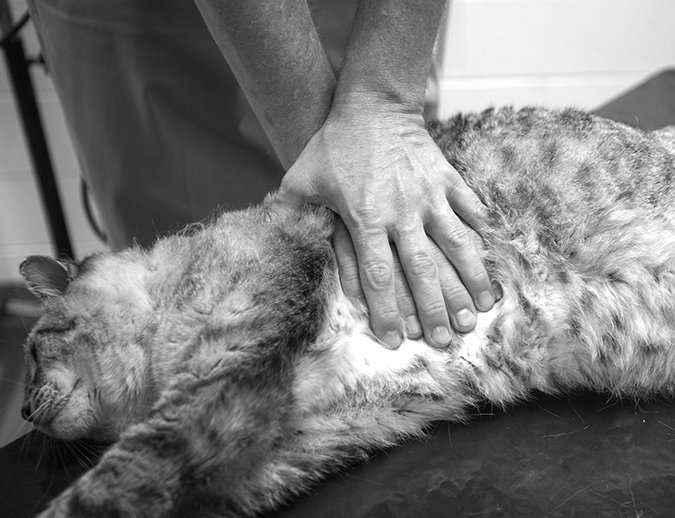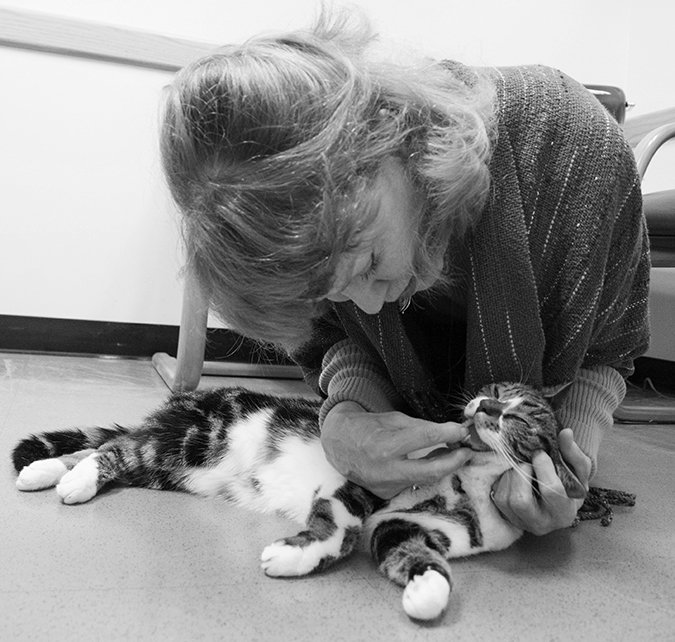Imagine returning home from work to see your cat lying motionless on the living room floor. You call his name, but he doesn’t respond, and you quickly realize he’s not breathing and fear his heart has stopped. The nearest veterinary clinic is 15 minutes away. You’re panicked, but for your cat’s sake, you realize you need to immediately begin cardiopulmonary resuscitation (CPR) to save his life.
Your cat cannot survive 15 minutes without his heart pumping oxygenated blood to his brain and vital organs. In a pet emergency, every minute counts. That’s why Cornell University College of Veterinary Medicine, in conjunction with the American College of Veterinary Emergency and Critical Care (ACVECC), now offers a one-hour online course for owners and professionals to teach them the latest steps in performing CPR on cats and dogs.
The 7 Essential Steps of CPR
If your cat suddenly collapses, perform the following steps to determine if cardiopulmonary arrest (CPA) has occurred and to initiate cardiopulmonary resuscitation (CPR).
1. Stimulate him by gently shaking him and shouting his name.
2. If the cat does not respond, take a few seconds to touch his chest and determine if the chest is rising and falling. If not, this is an indicator that he’s not breathing.
Cornell

3. Open your cat’s mouth, pull his tongue out to open his airway and look inside his mouth for anything that might be blocking the airway, such as a piece of food, scrap of chewed fabric or piece of a toy. Important: Don’t start CPR if the cat responds in any way such as moving or vocalizing. Such a patient is not in cardiopulmonary arrest. If your cat pulls his tongue back or clenches his mouth, don’t proceed with CPR or you could get bitten.
4. Clear the mouth of any obstructions.
5. Call for help from someone nearby. Ask him or her to get transportation and call the nearest veterinary clinic to alert it to this emergency situation so they can be ready to administer medical care when you arrive.
6. Begin doing CPR. Each cycle consists of delivering a series of 30 chest compressions followed by two mouth-to-snout breaths.
7. As soon as the car is available, load the cat into the car and continue CPR while proceeding to the veterinary clinic.
Providing Oxygen
CPR includes chest compressions and rescue breathing, which involves sealing a pet’s mouth and blowing air from your mouth directly into the pet’s nostrils to provide oxygen.
Pet CPR

“By knowing how to perform CPR, pet owners have a real chance at saving their pets,” says Daniel Fletcher, Ph.D., DVM, ACVECC, Associate Professor of Emergency and Critical Care at Cornell. Dr. Fletcher serves as the co-chair of the RECOVER Initiative, established in 2011 by leading veterinarians to publish the first evidence-based veterinary CPR guidelines. He is also the author of this new Pet CPR course now available online.
“The objective of this course is to teach you how to properly intervene if your dog or cat suddenly collapses and to teach you how to initiate CPR on the way to the veterinary clinic,” says Dr. Fletcher.
Cardiopulmonary arrest (CPA) occurs when the heart has stopped beating and the pet has stopped breathing. Blood flow and delivery of nutrients to the body have ceased. Within minutes after the start of CPA, vital organs begin to develop irreversible damage.
A cat can go into cardiac arrest because of a variety of causes, including trauma, exposure to extreme cold or hot weather, ingestion of toxins, airway obstruction, heart and lung disease, and other chronic or sudden onset of diseases.
“If there is any doubt your cat is in CPA after 10 to 15 seconds, you should start CPR even if you are not 100-percent sure,” Dr. Fletcher says.”It is more dangerous not to start CPR on a patient who has or has not arrested. Yes, every minute counts.”
Cornell

Cats are more likely to survive CPA if proper chest compressions and rescue breathing are started as soon as possible and if pauses in CPR are minimized. The two main goals of CPR are:
1. Providing blood flow by compressing (pushing on) the cat’s chest to mimic the normal function of a beating heart.
2. Providing oxygen and removing carbon dioxide by blowing air into the cat (mouth-to-snout) to mimic the normal process of breathing.
The chance of survival will ultimately depend on the underlying disease that caused the arrest, but by providing CPR immediately, you can increase your cat’s chances of survival and help protect his vital organs while transporting him to the nearest veterinary clinic.
Performing CPR consists of using hand techniques illustrated in the online course to correctly perform 30 chest compressions at a rate of 100 to 120 per minute followed by two rescue breaths. This cycle is then repeated until the cat starts responding or you arrive at the nearest veterinary clinic.
How-to Procedures
The online course provides illustrated step-by-step procedures and short videos on performing CPR. You’ll learn the proper hand placement on the cat’s chest to perform chest compressions based on the size of the kitten or cat.
Pet CPR

“The biggest issue for many people is performing chest compressions correctly because you have to use the correct technique,” says Dr. Fletcher. “Our course shows you the right way to do chest compressions, and it is important to avoid stopping and starting, stopping and starting because once you stop chest compressions, blood flow drops off. Every time you stop CPR, it can take about 45 seconds to get back up to that blood flow level, which is why we promote not stopping chest compressions for any prolonged period of time.”
The course also guides you on how to perform rescue breaths on cats. You will learn how to safely extend the cat’s neck so his snout is aligned with his spine to keep his airway open. “It’s important to seal the mouth and breathe into the cat’s snout, so your oxygenated air does not escape out the sides of the cat’s mouth and fails to reach her lungs,” says Dr. Fletcher.
You will also learn how to maintain the best posture to maximize the effectiveness of the chest compressions and rescue breaths and much more.
Enroll in the Pet CPR Course
The online Pet CPR course is open to anyone and takes about one hour to complete. The fee is $25. The self-paced course features short how-to videos and explains proper ways to perform chest compressions and rescue breathing on all types of dog and cat breeds.
At the end of the course, students must test what they learned by answering a 14-question assessment. Individuals who correctly score 70 percent or higher earn certificates issued by the American College of Veterinary Emergency and Critical Care. They will have unlimited number of opportunities to achieve a passing score.
To enroll in the course, visit ECornell.com.
Recommendations Came from More Than 1,000 Scientific Papers
The Reassessment Campaign on Veterinary Resuscitation (RECOVER) was founded in 2011 by the American College of Veterinary Emergency and Critical Care and the Veterinary Emergency and Critical Care Society to create the first evidence-based recommendations to resuscitate dogs and cats in cardiopulmonary arrest. RECOVER is directed by co-chairs Dr. Daniel Fletcher from the Cornell University College of Veterinary Medicine and Dr. Manuel Boller from the University of Melbourne Faculty of Veterinary and Agricultural Sciences.
More than 100 board-certified veterinary specialists reviewed more than 1,000 scientific papers related to CPR to develop the veterinary CPR guidelines.
Get Immediate Help
Performing CPR on even a small animal like a cat is strenuous. That’s why Dr. Fletcher encourages calling out for help in hopes another person can switch off on the chest compressions and rescue breaths. Once a vehicle is available, load your cat in the middle seat. If possible, have someone drive to the nearest veterinary clinic while you perform chest compressions and rescue breaths on your cat.
“Preparedness is key. By identifying where the closest emergency clinic is located now before a pet emergency occurs, you’ll be ready in the case of an emergency. Post the information in a convenient location in your home and program it into your phone,” Dr. Fletcher says. “I hope you never have to use what you will learn in this CPR course, but if your pet experiences cardiopulmonary arrest, you will now know what to do to maximize the chance of saving his life.”



